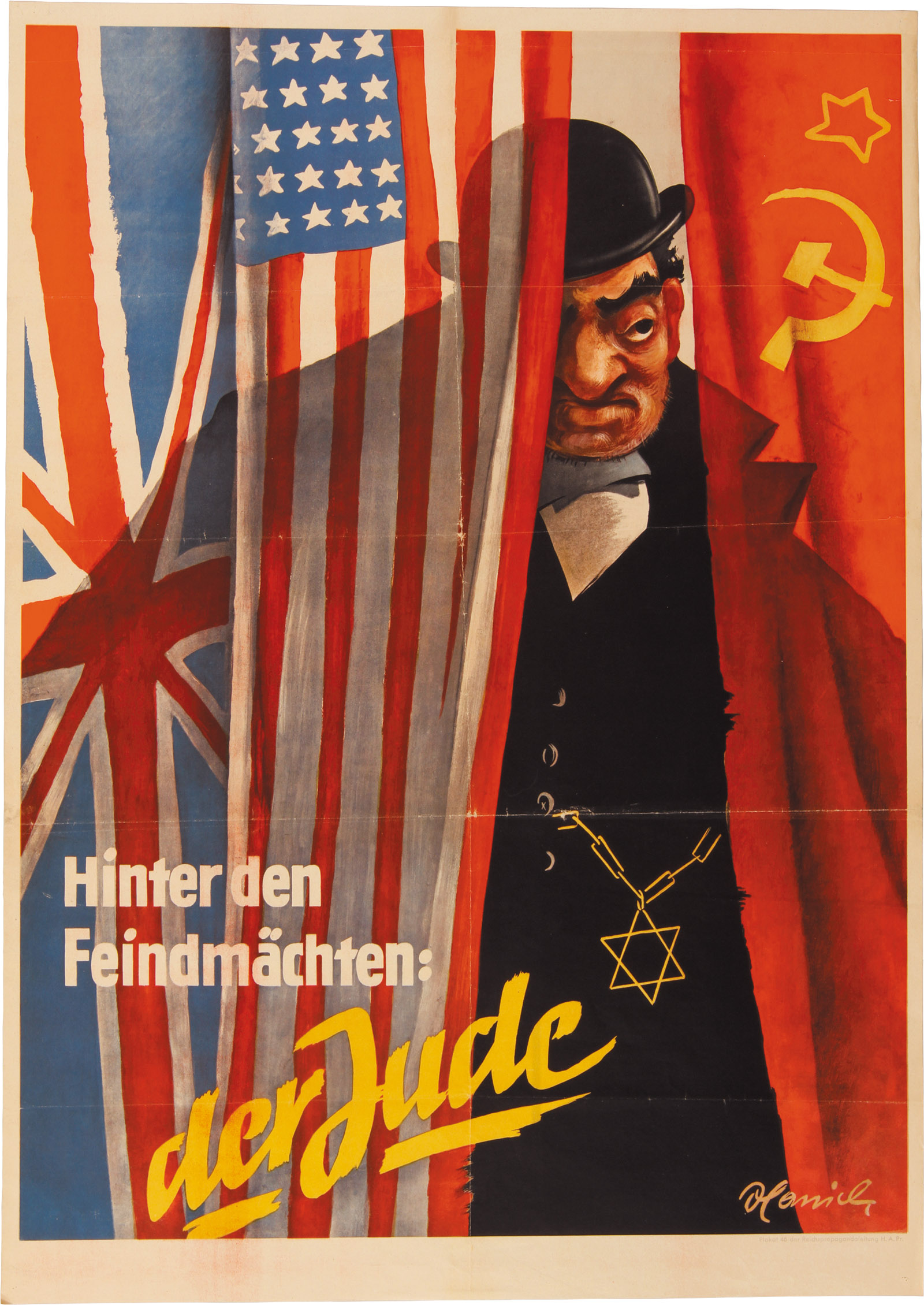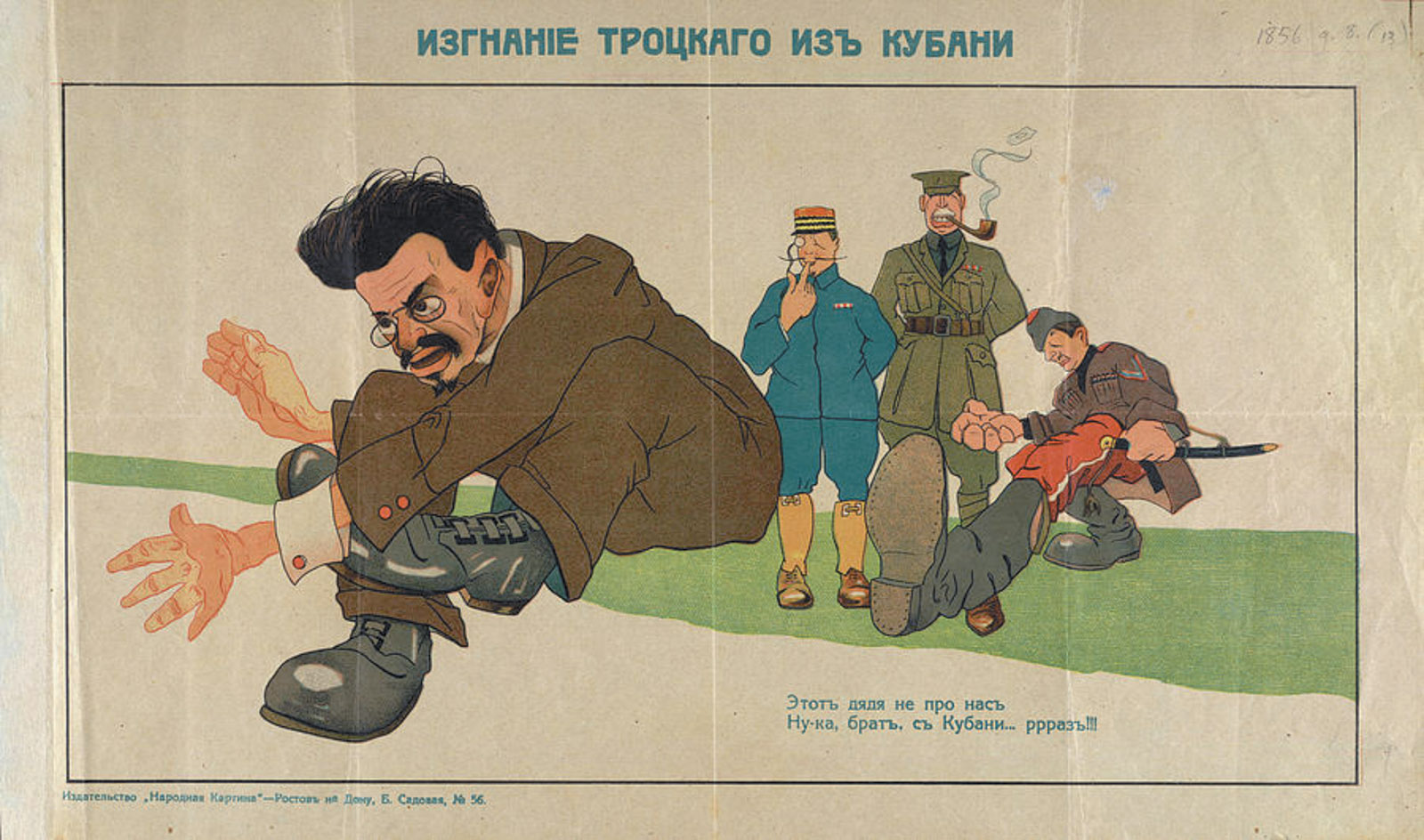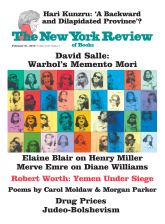
United States Holocaust Memorial Museum
‘Behind the Enemy Powers: The Jew’; a poster created by the Reich Propaganda Administration and displayed in the Grand Anti-Masonic Exhibition in Nazi-occupied Belgrade, which focused on the alleged Jewish-Communist-Masonic conspiracy to achieve world domination, 1941
One of the great merits of Paul Hanebrink’s A Specter Haunting Europe is its demonstration of how Europe’s most pervasive and powerful twentieth-century manifestation of anti-Semitic thought—the myth of Judeo-Bolshevism—emerged before the rise of National Socialism and has continued to have a curious life long after the Holocaust and the defeat of Nazi Germany. Hanebrink’s approach is not to repeat what he considers an error of the interwar era—the futile attempt to refute a myth on the basis of historical facts and statistical data. A small kernel of truth underpinned the stereotype of the Jewish Bolshevik: a number of well-known early Bolshevik leaders (Béla Kun, Leon Trotsky, Karl Radek, and others) were of Jewish origin. That Stalin killed almost all of them, that overall a very small percentage of Jews were Bolsheviks, and that many prominent non-Jewish revolutionaries (Lenin and Karl Liebknecht, for example) were mistakenly identified as Jewish had no countervailing impact, because, Hanebrink writes, the Jew as “the face of the revolution” was a “culturally constructed” perception.
Trying to discredit powerful political myths with mere facts, as we know all too well today, is a frustrating endeavor. Thus Hanebrink seeks instead to understand the historical background and the “cultural logic” of the myth of Judeo-Bolshevism—how it functioned and morphed through different phases. Ultimately Judeo-Bolshevism embodied, in the form of “Asiatic barbarism,” an imagined threat to national sovereignty, ethnic homogeneity, and Western civilization conceived as traditional European Christian hegemony. It fused, in short, political, racial, and cultural threats into a single “specter haunting Europe.”
Hanebrink notes that amid the exhaustion, defeat, and political dissolution of many European countries at the end of World War I, the threat of the spread of Bolshevik revolution from Russia into Europe caused not only widespread fear and loathing but fear and loathing that identified Jews as the real cause of Bolshevism. He is correct, I think, to point out that this pervasive identification required more than the prominence of Jewish revolutionary leaders, and that Judeo-Bolshevism was constructed from the “raw materials” of earlier anti-Semitism. For Hanebrink the “three venerable pillars” of anti-Jewish thought were the attributions to the Jews of social disharmony, conspiracy, and fanaticism, which made Judeo-Bolshevism both a coherent idea and a ubiquitous, self-evident assumption.
Here I think that Hanebrink could have been more concrete; in particular he could have shown how easily the negative stereotype of the Jew that had originated in the Middle Ages could be updated for the twentieth century. Even before the crisis of 1918–1919, which combined the experiences of defeat and revolution for many Europeans, Jews were invariably disproportionately represented in liberal and socialist parties because they were not welcome to participate in conservative and Catholic political parties. The tendency to stigmatize anything to the left of conservative as Jewish was already evident in 1912, when the electoral victory in Germany of the liberal democrats, Social Democrats, and Catholics—who also made up the “Weimar Coalition” of 1919 that was largely responsible for drafting the Weimar Constitution, so despised by German conservatives—was dubbed the “Jew election.”
The Jew of the Middle Ages, an infidel, became the Jew of the twentieth century, a political subversive. With emancipated Jews being the most visible beneficiaries of the modern commercial and industrial economy by the end of the nineteenth century, the medieval epithet of Jewish usury had already been replaced with that of rapacious Jewish capitalism, and after 1914 the image of the Jew as an economic threat was only intensified by accusations of Jewish war profiteering and black marketeering. The Jew as a clannish outsider in medieval Christendom was easily transformed into the Jew as an unassimilable minority and alien internal threat, at a time when other European nationalities were striving to construct new nation-states out of the ruins of multiethnic empires.
As a result of the postwar flood of refugees and the return of prisoners of war (like Béla Kun) from a Russia wracked by revolution and civil war, the “wandering” Jews among this mass of dislocated people were easily seen as an invading horde and source of revolutionary contagion. With the Bolsheviks in Russia preaching the primacy of international revolution over loyalty to one’s own nation-state and threatening social revolution and nationalization of property, the basis for the “cultural construction” of Judeo-Bolshevism, Hanebrink argues, was all too readily available. In April 1919 Eugenio Pacelli, the papal nuncio in Munich (and future Pope Pius XII), reported to the Vatican that the communist-led Bavarian Soviet (which existed for less than a month before it was crushed by the counterrevolutionary Freikorps) was composed entirely of Jews. One of its leaders, Max Levien, was described as “also a Russian and a Jew,” “dirty,” “vulgar,” “repulsive,” and “sly.” Levien was in fact a Russian émigré to Germany, a four-year veteran of the German army, and a non-Jew. This did not, as Hanebrink observes, signify an exceptionally anti-Semitic disposition on the part of Pacelli but simply reflected the “utterly typical” consensus of virtually all European conservatives at that time.
Advertisement
From the beginning of World War I, tsarist Russia had treated its Jewish subjects as unreliable and potentially disloyal. Its military forcibly displaced some 500,000 to one million Jews from combat zones. The very approach of the Russian army thus also instigated the flight of many other Jews from the eastern regions of the Austro-Hungarian Empire to the presumed safety of cities like Vienna and Budapest. The Russian Revolution erupted amid already existing fears about Jewish loyalty and floods of displaced Jews, and intensified those fears. The “panic” over Judeo-Bolshevism, Hanebrink argues, “flourished in ground that had been prepared by wartime paranoia about Jewish loyalty.” In what Hanebrink calls the “long World War I” in Eastern Europe, including the Russian civil war, the Soviet-Polish war, and the Romanian ouster of the Béla Kun regime and Miklós Horthy’s subsequent White Terror in Hungary, “sovereignty panic” intensified the catastrophic consequences for Jews, particularly in Poland, Hungary, Romania, and Ukraine.
Atrocities against Jews led to Jewish appeals to the Allies and the subsequent imposition of minority rights treaties on Eastern European nations. In a vicious circle, these regimes in turn resented Jews as the cause of this infringement on their sovereignty, which they saw as further evidence of Jewish disloyalty. They insisted even more vehemently on the Judeo-Bolshevik connection to justify their past mistreatment of Jews and successfully exploited the Allies’ desire for a cordon sanitaire in Eastern Europe to prevent the further spread of Bolshevism. For instance, the Polish army received crucial military aid to help it resist the Soviet invasion of 1920 even as it interned many of its own Jewish soldiers. All of this, it must be emphasized, took place before history’s most notorious purveyor and champion of the myth of Judeo-Bolshevism had emerged from obscurity on the streets of Munich.
Adolf Hitler combined his belief in that myth with a race-based theory of history and a vision of German Lebensraum in the East, which culminated in his war of territorial conquest, ideological crusade against Bolshevism, and campaign of genocide against Jews. As Hanebrink notes, adherents of the Judeo-Bolshevik myth now had to reconcile themselves with Hitlerian and German hegemony. They did so in different ways. Hungary allied with Germany for territorial gain (Hitler’s return of northern Transylvania), sent troops to the Eastern Front, intensified its discrimination against its Jewish population, and expelled foreign Jews to the killing fields of Ukraine, but did not surrender its own Jews to the Final Solution until the German overthrow of the Hungarian government in March 1944. Romania not only fought alongside Germany and gained territories to the east but directly killed more Jews (over 300,000) than any other of Hitler’s allies, stopping only when its leaders sensed that German victory was no longer inevitable.
For Poles the situation was much more complicated. Having turned down Hitler’s offer before the war of a junior partnership based on shifting Poland’s borders eastward, they were partitioned by Germany and the Soviet Union. However, the experience of both Polish and Jewish victimization under the Nazi occupation did not alter predominant Polish views about their Jewish neighbors. The flight of many Jews from western to eastern Poland, the obvious relief of Jews in eastern Poland that they had been occupied by Stalin rather than Hitler, and ultimately the desperate hope of Polish Jews for rescue and liberation by the Red Army only confirmed for many Poles their belief in Judeo-Bolshevism.
Within Germany the myth of Judeo-Bolshevism was crucial for cementing the complicity of the military in Hitler’s “war of annihilation” against the Soviet Union, portrayed as a “preventive defense” of German and Western civilization. The myth also played “a crucial role in the origins of the Final Solution.” Hanebrink cites the notorious order of General Walter von Reichenau, the commander of the Sixth Army on the southern front, less than two weeks after the Babi Yar massacre in Ukraine in 1941: “The fundamental goal of the campaign against the Jewish-Bolshevik system is the total defeat of its means of power and the extermination of the Asiatic influence in the European sphere of culture.” Thus the “hard but just punishment” meted out to “Jewish subhumans” was necessary “to free the German Volk from the Asiatic-Jewish danger once and for all.”
Reichenau’s order did not simply reflect the unhinged rantings of one ideologically zealous Nazi general, and Hanebrink could have offered far more evidence of the impact of the Judeo-Bolshevik myth on German military thought and behavior, if this had been the main point of his book. For instance, further north, sixty-one German army officers were invited to meet with top SS officers (including Arthur Nebe, commander of Einsatzgruppe B, and Higher SS and Police Leader Erich von dem Bach-Zelewski) in Mogilev on September 24–26, 1941, for orientation on the partisan threat. The gist of the presentations was the equation Jew=Bolshevik=partisan, accompanied by a demonstration killing of thirty-two Jews in a nearby village by members of Police Battalion 322. Subsequently, military units behind the central front were among the Wehrmacht’s most lethal killers of Jews. And the fatal linkage between Jews, Bolsheviks, and partisans was most catastrophically demonstrated in Himmler’s December 29, 1942, report to Hitler on the results of the “anti-partisan campaign” for the preceding four-month period of August–November. It listed the killing of 1,337 “bandits” in battle, 737 immediately after battle, and 7,828 after interrogation. Furthermore, it listed the execution of 14,256 “accomplices and suspects” and finally 363,211 Jews.
The total defeat of Nazi Germany and exposure of its crimes did not entirely discredit the notion of Judeo-Bolshevism. One of the most fascinating aspects of Hanebrink’s book is his discussion of its strange post-1945 afterlife. In Western Europe, anti-communism, a term that increasingly supplanted “anti-Bolshevism” beginning in the 1930s, took a new direction, but in Eastern Europe the Judeo-Bolshevik myth continued to shape how local populations remembered the war and understood the Soviet imposition of Communist regimes.
The Allied occupation, the war crimes trials and denazification, but above all the division of Germany and the onset of the cold war led to the emergence in Western Europe of an anti-communism that was pro-democratic, pro-American, and not anti-Semitic. Underlying this transformation were two concepts. The first was that of totalitarianism, by which discredited and defeated fascism was equated with communism. The German churches in particular—previously highly nationalistic, authoritarian, and anti-Semitic, and thus all too often fellow travelers of the Nazi regime’s campaigns against liberalism, Marxism, and Jews—now portrayed themselves as resisters to and victims of that regime, which like the Soviet Union had manifested the evils of the secular, materialistic, ungodly state run amok. West Germany’s new self-image of Christian Democracy pitted against totalitarianism dovetailed with the second concept—the American notion of Judeo-Christian values as the basis of both democracy and Western civilization in its cold war opposition to godless communism. By embracing the cold war, assimilationist American Jews finally severed the old identification between Jews and Bolsheviks, but at the cost of giving priority to anti-communism over Holocaust memory. It was not until the late 1970s that the Holocaust began to obtain the position it currently holds in American consciousness.
In the countries of Eastern Europe occupied by the Red Army and subjected to communist regimes, a very different dynamic occurred. The populations of Poland, the Baltic states, Ukraine, Romania, and Hungary in particular continued to see what happened after 1945 through the lens of Judeo-Bolshevism. The installation of Communist Party rule was seen as bringing the Jews to power, and the trial and punishment of Nazi collaborators was seen as Jewish revenge, not justice.
Both Moscow and local Communists were eager to shed the stigma of identification with Jews. Most of the remaining Polish Jews, for instance, were allowed to leave the country after the Kielce pogrom in July 1946, so the regime would not have to protect them. Prominent Jewish Communists, like Rudolf Slánský and his colleagues in Prague, were tried and executed; Ana Pauker in Romania and the non-Jewish but philo-Semitic Paul Merker in East Germany were purged. Only Stalin’s timely death in 1953 prevented the “doctors’ plot” from exploding into anti-Jewish terror in the USSR. A communist anti-Semitism in the guise of anti-Zionism and anti-cosmopolitanism was employed both in intraparty rivalries (most famously by Władysław Gomułka in Poland in 1968) and as international propaganda. Public memory of the Holocaust was silenced.
In the 1970s and 1980s an emerging consciousness and memory of the Holocaust transformed it in the West into the paradigm of radical evil and the civics lesson that toleration, human rights, and respect for religious and racial difference were essential values of liberal democracy. The resulting “hegemony of Holocaust memory,” which eclipsed the concept of totalitarianism by giving primacy to the crimes of Hitler over those of Stalin and the suffering of Jews over that of the victims of Communism, was challenged from two directions. The German scholar Ernst Nolte tried to portray the horrors of Asiatic Bolshevism as the factor that elicited a rational defensive response in the form of National Socialism. The American historian Arno Mayer tried to portray communism as the primary target of Nazism, with the Holocaust (or “Judeocide,” as he termed it) as a secondary aim—a byproduct. Both were dismissed as attempts to relativize or trivialize the Holocaust.
Post-1989 Eastern Europe took a different turn, however, with many countries resisting the “hegemony of Holocaust memory” as the ticket of admission into the Western European community of liberal democracies. In that memory, Jews were the quintessential innocent victims, while the populations of Eastern Europe, afflicted by anti-Semitism and the myth of Judeo-Bolshevism that they shared with the Nazis, had been accomplices and beneficiaries of the Holocaust. But in the memory of many Eastern Europeans, they were the innocent victims of the “double occupation” of Hitler and Stalin, while the not-so-innocent Jews had been the accomplices and beneficiaries of Communist rule.
In short, Judeo-Bolshevism had returned as an essential component of the memory wars, and the Holocaust scholarship and civics pedagogy of the West were seen as national defamation in countries like Poland, Hungary, Romania, and the Baltic States. The explosive impact in Poland of Jan Gross’s book Neighbors (2000), which documented the participation of Polish villagers in the massacre of the Jews in Jedwabne, the bitter public debate and discomforting historical research by younger Polish scholars that followed, and the notorious 2018 law banning the attribution of Nazi crimes to the Polish nation illustrate this dynamic of reacting to Holocaust scholarship as national defamation.
In his conclusion Hanebrink argues that the myth of Judeo-Bolshevism is no longer a threat driving Europeans to panic, but rather has been relegated to the politics of contested memory. Unfortunately, I fear that the rantings and conspiracy theories disseminated by the likes of Viktor Orbán against George Soros and the allegedly Jewish forces of globalization, and the chants of “Jews will not replace us” by white supremacists in Charlottesville, demonstrate that anti-Semitism, even if not specifically in the form of Judeo-Bolshevism, still has traction. But Hanebrink is correct, I think, to argue that the myth of Judeo-Bolshevism has been supplanted by another perceived threat likewise constituted from a fusion of race, culture, religion, and political ideology. This is the “Islamization of the West,” embodied in the influx of Muslim immigrants who are considered dangerous, alien, disloyal, extremist, and unassimilable, and thus once again threaten the survival of national sovereignty, ethnic homogeneity, and Western civilization. In place of Judeo-Bolshevism, a new hybrid specter—“radical Islam” or “Islamic terror”—is haunting Europe.
This Issue
February 21, 2019
Men’s Lib
The Star of the Silken Screen




